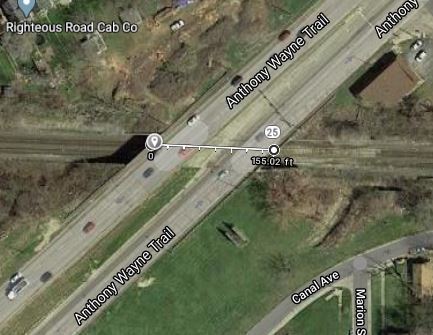- Details
- Hits: 3889
Story: Disaster in Toledo's railroad tunnel...
What tunnel? You have probably never heard of it.
But on December 3, 1891, it happened. The Lake Shore & Michigan Southern did indeed have a short tunnel under the Miami & Erie canal and the parallel Clover Leaf railroad in downtown Toledo. The tunnel was 75 feet long, and located 3/4 of a mile west of the current Amtrak station. Today, Anthony Wayne Trail crosses over the railroad at this point on a bridge.
The disaster was a rear-end collision around 4:45 p.m. A Lake Shore train, No. 6 known as the Boston and Chicago Special, travelling eastbound, passed a restricting target signal 300 feet before the tunnel. The engineer applied the brakes and slacked up because another train was ahead.
Following closely behind, a Flint & Pere Marquette passenger train headed for Toledo's Union depot (from Air Line Junction) came through the same tunnel and plunged into the rear coach of the Lake Shore train.

The F&PM engine plowed its way through the car until the pilot was more than midway of the coach. The seats and floor were torn up and the unfortunate passengers bruised and maimed. Some were badly scalded by the escaping steam from broken pipes. The crash was described by those who heard it as terrific, and was followed by screams of agony from the wounded.
The times between these two trains were only two minutes apart. The Lake Shore train was running a bit behind. When the train stopped for the signal, the brakeman was sent back. He discovered that the tunnel was full of smoke and steam and heard the oncoming F&PM train, consisting of an engine and three cars. Fearful that he would be killed if he went into the tunnel, he held back and an instant later the F&PM train went by at a speed sufficient to prevent its stopping and struck the preceding train.
The tunnel was full of smoke, but the engineer of the F&PM train, which was already in the tunnel, saw the signal, and also the rear lights of the doomed car. He shut off steam and he and his fireman threw themselves flat on the floor of the cab, so as to be protected by the boiler. Both escaped unhurt, except for a severe shaking up. This engineer was a "new man" and this was his first run over the Lake Shore to Toledo union depot.
In the Lake Shore coach, 6 passengers died and dozens were injured. Most were treated at St. Vincent hospital, which continues to serve Toledo today.
[DFP-1891-1130} The Daily Times from New Philadelphia, Ohio was widely quoted in this story.
----------
Additional background: The Miami & Erie canal was completed about 1845. It ran from Toledo to Cincinnati, creating a water route between Lake Erie and the Ohio River. It was in place at least 10 years before the existing Lake Shore right-of-way was routed underneath it. The "tunnel" was 75 feet long, which included the overhead crossing of the canal and Clover Leaf railroad line into downtown from the south.
It is interesting to consider that the canal was well above the level of the Lake Shore railroad and required the railroad to tunnel underneath it. According to historical maps of this area, the canal also was raised overtop of nearby Swan Creek, which it crossed just north of this location.
Today, the canal is gone at this location, as is the Clover Leaf. The current bridge at this location is for Anthony Wayne Trail, a boulevard divided highway. The current bridge over the NS (former Lake Shore), is now 155 feet in length.
1892. September 28. After a trial lasting two weeks the suit of John H. COnway, of Millville, Mass. vs. the Lake Shore & Michigan Southern and the Flint & Pere Marquette railroad companies, for damages for personal injuries received in the Toledo Tunnel disaster on November 28 last, resulted to-night in a verdict of no cause of action against the F&PM, and a verdict for the plaintiff against the Lake Shore for $21,553.25. Conway's suit was for $25,000 and is one of twelve against the same companies growing out of the disaster, the amounts ranging from $10,000 to $50,000. The trial early resolved itself into a fight between the companies, and it was spirited throughout. [DFP-1892-0929]
Note: As a result of this collision, the Lake Shore advised the F&PM that they could no longer run on their line between Monroe and Toledo unless they agreed to hold the Lake Shore harmless. The F&PM ended up building their own line between the two cities in 1896. [MRL]
Bibliography
The following sources are utilized in this website. [SOURCE-YEAR-MMDD-PG]:
- [AAB| = All Aboard!, by Willis Dunbar, Eerdmans Publishing, Grand Rapids ©1969.
- [AAN] = Alpena Argus newspaper.
- [AARQJ] = American Association of Railroads Quiz Jr. pamphlet. © 1956
- [AATHA] = Ann Arbor Railroad Technical and Historical Association newsletter "The Double A"
- [AB] = Information provided at Michigan History Conference from Andrew Bailey, Port Huron, MI

